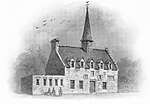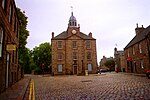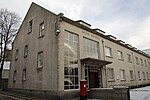The University of Aberdeen (Scots: University o' 'Aiberdeen; abbreviated as Aberd. in post-nominals; Scottish Gaelic: Oilthigh Obar Dheathain) is a public research university in Aberdeen, Scotland. It was founded in 1495 when William Elphinstone, Bishop of Aberdeen and Chancellor of Scotland, petitioned Pope Alexander VI on behalf of James IV, King of Scots to establish King's College, making it one of Scotland's four ancient universities and the fifth-oldest university in the English-speaking world. Along with the universities of Edinburgh, Glasgow, and St Andrews, the university was part of the Scottish Enlightenment during the 18th century.
The university comprises three colleges—King's College, Marischal College, and Christ's College—that are now mainly ceremonial. The university as it is currently constituted was formed in 1860 by a merger between King's College and Marischal College, a second university founded in 1593 as a Protestant alternative to the former. The university's iconic buildings act as symbols of wider Aberdeen, particularly Marischal College in the city centre and the crown steeple of King's College in Old Aberdeen. There are two campuses; the predominantly utilised King's College campus dominates the section of the city known as Old Aberdeen, which is approximately two miles north of the city centre. Although the original site of the university's foundation, most academic buildings apart from the King's College Chapel and Quadrangle were constructed in the 20th century during a period of significant expansion. The university's Foresterhill campus is next to Aberdeen Royal Infirmary and houses the School of Medicine and Dentistry as well as the School of Medical Sciences. Together these buildings form one of Europe's largest health campuses. The annual income of the institution for 2021–22 was £260.9 million of which £50.8 million was from research grants and contracts, with an expenditure of £313.4 million.Aberdeen is consistently ranked among the top 160 universities in the world and is ranked within the top 20 universities in the United Kingdom according to The Times and The Sunday Times, and 13th in the UK according to The Guardian. Aberdeen has 15,185 students from undergraduate to doctoral level (as of 2019/20), including many international students. An abundant range of disciplines are taught at the university, with 650 undergraduate degree programmes offered in the 2012–13 academic year. Aberdeen has educated a wide range of notable alumni, and the university played key roles in the Scottish Reformation, Scottish Enlightenment, and the Scottish Renaissance. Five Nobel laureates have since been associated with the university: two in Chemistry, one in Physiology or Medicine, one in Physics, and one in Peace.








